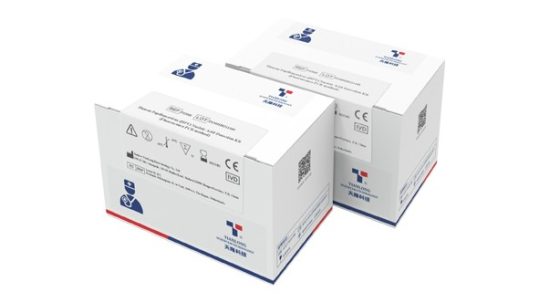Real Time PCR Kit
Our PCR reagents and kits feature advanced enzyme technology and buffer formulations for reliable amplification, robust reverse transcription, and high-quality real-time PCR data.


P761H - SARS-CoV-2 Nucleic Acid Direct Detection Kit
The TianLong SARS-CoV-2 Nucleic Acid Detection Kit is intended for the qualitative detection of SARS-CoV-2 nucleic acid by Direct Real-time reverse transcription Polymerase Chain Reaction (Direct Real-time RT-PCR) method.

Real Time PCR Detection Kit
Tianlong Gentier96 series is a real time PCR detection system to meet the experimental needs of high-end users. The product has various advantages including advanced efficient temperature control system and photoelectric system, powerful and easy-to-use software analysis function, and user-friendly control method, etc.
It can easily process downstream multiplex gene detection, quantitative analysis, SNP analysis, dissociation curve analysis and other applications.
It is widely used in medical institutions at all levels, universities and research institutes, CDC, Entry-Exit Inspection and Quarantine Bureau, Public Security Criminal Evidence Identification Center, veterinary centers, food and dairy product factories, as well as other fields and industries.

P181H - 96T Mycoplasma Pneumoniae Nucleic Acid Detection Kit
Mycoplasma Pneumoniae (MP) Nucleic Acid Detection Kit is used for qualitative detection of Mycoplasma pneumoniae nucleic acid in human sputum and throat swab samples.

P109H - 32T Mycoplasma Pneumoniae Nucleic Acid Detection Kit
Mycoplasma Pneumoniae (MP) Nucleic Acid Detection Kit is used for qualitative detection of Mycoplasma pneumoniae nucleic acid in human sputum and throat swab samples.

P120H- HPV Nucleic Acid Detection Kit
Vaccination rates and the incidence of cervical adenocarcinoma are both on the rise, making HPV genotype testing an important tool to help stratify risk and guide patient management. High-risk HPV genotypes 16, 18 account for 70% of cervical cancer worldwide. Tianlong’s Human Papillomavirus (HPV) Nucleic Acid Detection Kit is a qualitative in vitro test for detection of 18 high-risk HPV types(HPV 16,18,26,31,33,35,39,45,51,52,53,56,58,59,66,68,73 and 82), which can specifically identify types HPV 16 and HPV 18 while concurrently detecting the rest of other high-risk types.

P106H - Herpes Simplex Virus (HSV) II Nucleic Acid Detection Kit
The kit is used for qualitative detection of HSV II nucleic acid in male urethral swab samples or female cervical swab samples.
Herpes simplex belongs to the subfamily of the herpesvirus family, and the size of the virus plasmid is about 180nm. The HSV genome is approximately 152kb, with 34 genes, encoding more than 70 polypeptides. HSV II mainly causes genital infections below the waist, which are transmitted through sexual contact.

P139H - Human MTHFR MTRR Gene Polymorphism Detection Kit
This kit is a supplementary reagent for the “Human MTHFR Gene Polymorphism Detection Kit”, which can qualitatively detect the polymorphism of human MTHFR gene locus c.1298 and human MTRR gene locus c.66. Methylenetetrahydrofolate reductase (MTHFR) is a key enzyme in the methionine-folate metabolism system,Together with MTRR, and maintains the normal metabolism of folic acid with methionine synthase reductase(MTRR). In addition, it is also involved in maintaining normal homocysteine levels in the body. MTHFR and MTRR gene encode the key enzymes of folate metabolism and the mutations can reduce the activity of these enzymes, cause folate metabolism disorders, low folate levels and hyperhomocysteinemia. People with abnormal MTHFR gene has low enzyme activity and folic acid metabolism disorders, which lead to a significantly increased risk of neonatal neural tube defects, Down syndrome, and cleft lip and palate. And such people need more folic acid supplements to achieve the desired effect.

P743H - SARS-CoV-2 Delta Mutant Nucleic Acid Multiplex Detection Kit
TianLong SARS-CoV-2 RNA and E484Q/P681R Multiplex Detection Kit is intended for the qualitative detection of SARS-CoV-2 RNA and the E484Q/P681R mutant in S gene of SARS-CoV-2 by Real-time Reverse Transcription Polymerase Chain Reaction (Real-time RT-PCR) method. The test results are only for clinical reference, which can not be used as the sole basis for confirming or excluding cases.

P105H - UU Nucleic Acid PCR Detection Kit
The kit is used for qualitative detection of ureaplasma urealyticum nucleic acid in male urethral swab samples or female cervical swab samples. Ureaplasma urealyticum has the closest relationship with reproductive health. It can cause urogenital infections and is considered to be an important pathogen in nongonococcal urethritis after Chlamydia (50%).
